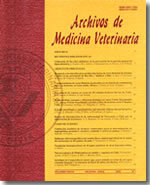Determination of abamectin-triclabenzadole residues in bovine tissues
Main Article Content
Abstract
Abamectin (ABM) and Triclabendazole (TCBZ) are two potent antiparasitic drugs that differ in their chemical structure and spectrum of action. In this study, a sensitive HPLC-method was developed and validated to determine ABM and TCBZ residues in bovine edible tissues, and the pattern of tissue depletion of an oral formulation containing the association abamectin (ABM) - triclabendazole (TCBZ) was characterized. Sixteen parasitefree heifers (232 ± 37.5 kg body weight) were treated with the oral formulation at a dose rate of 0.2 mg of ABM/kg and 10mg of TCBZ/kg of live weight. Treated animals were slaughtered weekly in randomly selected groups of three to four animals from day 7 until day 42 post-treatment. Concentration profiles of the drugs were determined in liver, kidney, muscle and fat tissues. Two nontreated animals were slaughtered in order to obtain blank tissue samples to validate the analytical methodology. Drug concentration profiles were determined by a validated HPLC analytical methodology using fluorescence detection for ABM and UV- detection for TCBZ. The highest concentration of ABM was observed in liver samples (4.02 ng/g) and was maintained for 14 days. In the case of TCBZSO2 the highest concentration was observed in the kidney (0.79 µg/g) and persisted for a period of 14 days.

